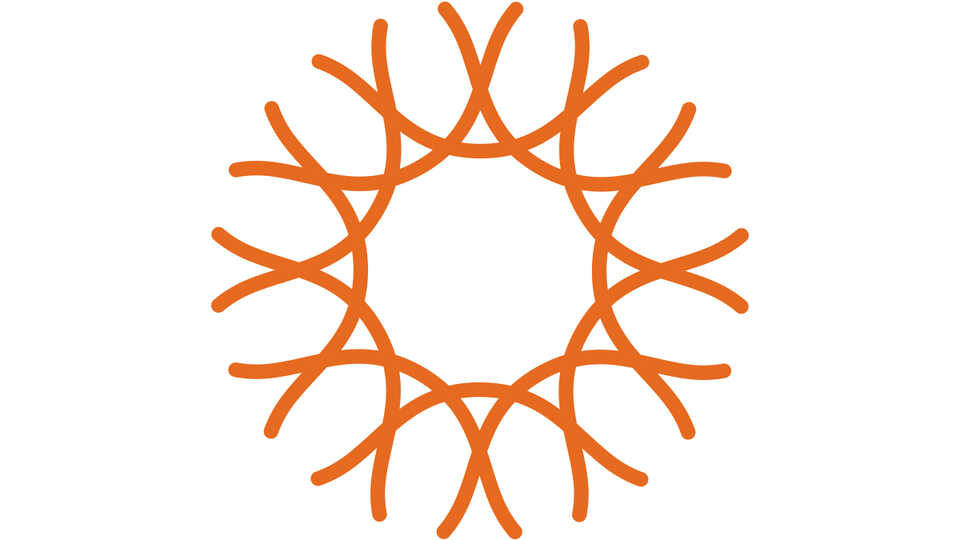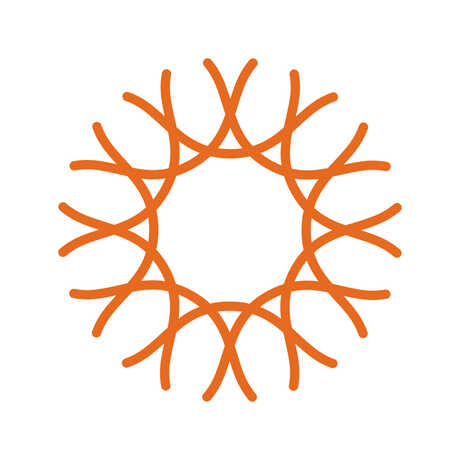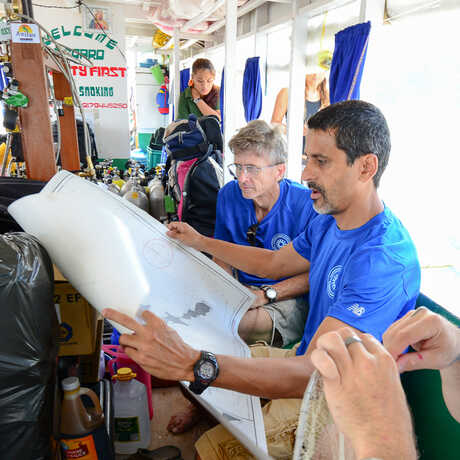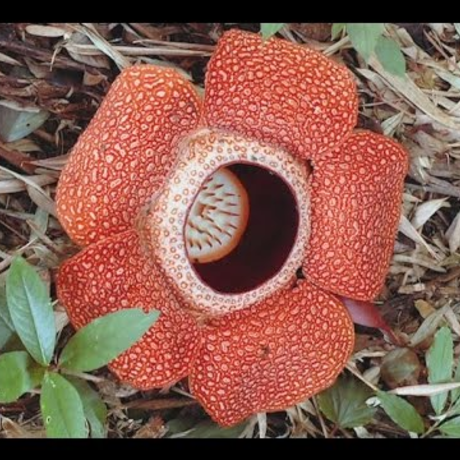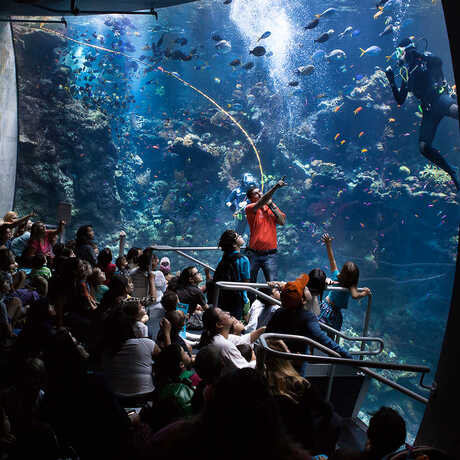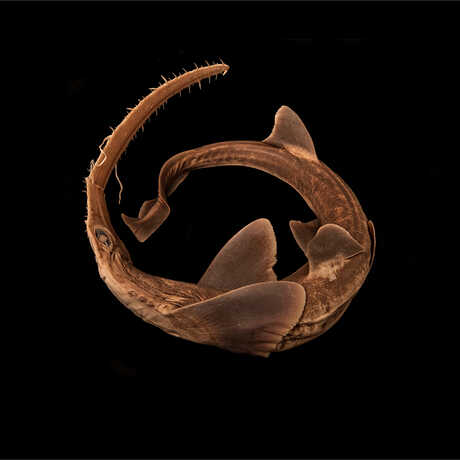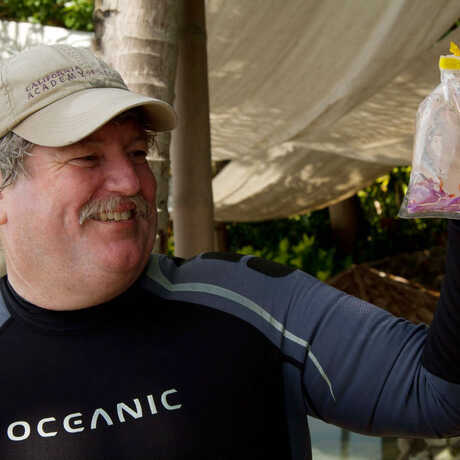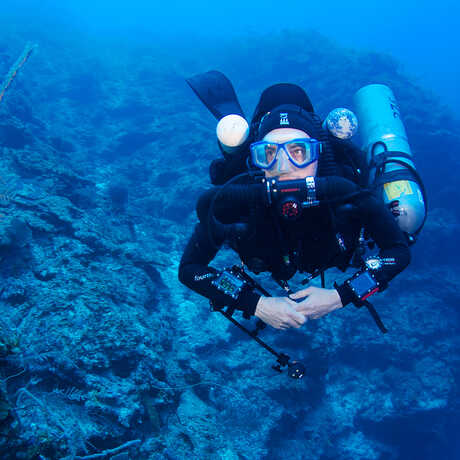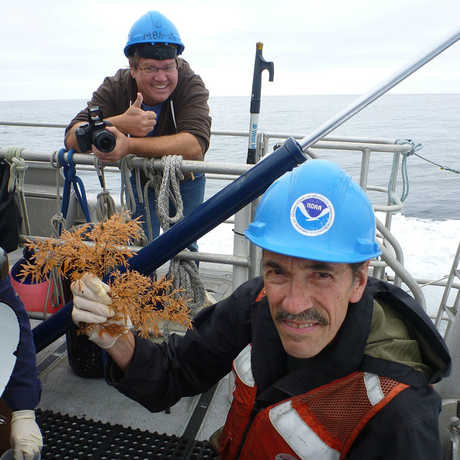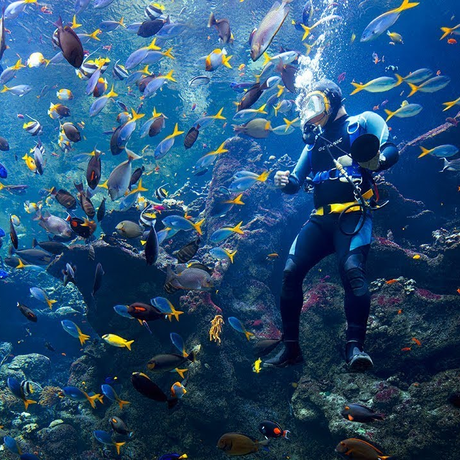Our scientific divers are on the frontlines of some of the most exciting exploration happening today. Meet the Academy dive staff and learn more about the technology, training, and expertise that makes it happen.
Shallow Water Team
Led by Dr. Terry Gosliner, the shallow water team dove at sites within marine protected areas and sites that are not protected to document species diversity and richness. They investigated the variety of zooxanthellae (microscopic algae) in a variety of organisms. Zooxanthellae lend their color to host corals. A lack of zooxanthellae, or coral bleaching, is a sign of a stressed reef. Additionally, they searched for a new genus of pygmy pipehorse and a new species of eel.
- Fishes: Dr. Healy Hamilton, Dave Catania, Dr. Kent Carpenter, Dr. Demian Willete, and Don Dumale
- Mollusks: Dr. Terry Gosliner and Dr. Brian Simison
- Coelenterates: Dr. Gary Williams, Dr. Wilfredo Y. Licuanan, Clarissa Reboton, and Katrina Luzon
- Echinoderms: Dr. Rich Mooi and Jay Gorospe
- Crustacea: Dr. Bob Van Syoc and Marivene Manuel Santos
- Annelids: Chrissy Piotrowski
- Zooxanthellae: Dr. Terry Gosliner, Dr. Gary Williams, Dr. Brian Simison, and Dr. Michele Weber
- Nudibranchs: Elizaldy Maboloc, Inggat Laya Calisagana, Rafael Dumalan, and Vanessa Knutson
- Invertebrates: Peter Cadapan, Val Borja, and November Romena
- Sponges: Joseph Comendador
Deep Water Team
Led by Dr. Rich Mooi, the deep water team spent nine days aboard the MV DA-BFAR trawling and trapping in protected and unprotected waters to understand the species diversity and richness. They surveyed benthic habitats to 2000 m in depth. The deep water is less known than the shallow waters and scientists were excited for their new discoveries.
- Fishes: Dave Catania, Dr. Tomio Iwamoto, Dr. John McCosker, Vincent Hilomen, and Don Dumale
- Coelenterates: Dr. Gary Williams
- Mollusks: Dr. Terry Gosliner
- Echinoderms: Dr. Rich Mooi, Ludivina Labe, and Zenaida Salazar
- Crustacea: Dr. Bob Van Syoc and Marivene Manuel Santos
- Annelids: Chrissy Piotrowski
- Other: Dr. Rachel Gotanco, Evelyn Mendoza, and Ms. Aissa
Terrestrial Team:
Led by Dr. Peter Fritsch, the terrestrial team explored numerous montane forests and freshwater lakes. This was the first significant study in the Philippines by our Botany team. Academy terrestrial research in the Philippines dates back to 1908 with the department of Herpetology.
- Angiosperms: Dr. Peter Fritsch, Dr. Frank Almeda, Dr. Darin Penneys, and Dr. Edwino Fernando
- Bryophytes: Dr. Jim Shevock and Dr. Benito Tan
- Arachnids: Dr. Charles Griswold, Hannah Wood, Dr. Natalia Chousou Polydouri, and Vanessa Knutson
- Reptiles and amphibians: Dr. Rafe Brown, Cameron Siler, David McLeod, and Dr. Arvin Diesmos
- Fish: Dave Catania and Dr. Demian Willete
Education and Media Outreach Team
Led by Dr. Meg Burke, the education and outreach team documented this trip and shared discoveries, explorations, and results. The impact of their work has extended well past the dates of the expedition.
Dr. Meg Burke, Roberta Brett, Stephanie Stone, David McGuire, and Tim Horn
The Steinhart Aquarium Team
Led by Bart Shepherd, the Steinhart Aquarium team surveyed and documented the dive sites that served as the inspiration for the aquarium's 212,000 gallon Philippine Coral Reef exhibit. Steinhart biologists responsibly collected coral, cephalopods, and other invertebrates for captive propagation, research, and display at our Golden Gate Park facility. We are the only public aquarium permitted to collect stony corals in the Philippines. This work built upon previous trips and allowed us to exchange cultured Philippine stony corals with other institutions. Diving Safety Officer Elliot Jessup was on site to assist both the Steinhart Aquarium and the Shallow Water Team.
Bart Shepherd, Matt Wandell, Rich Ross, and Elliot Jessup
